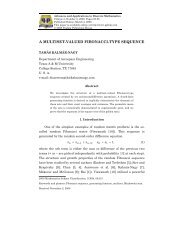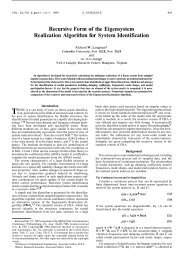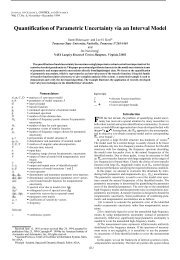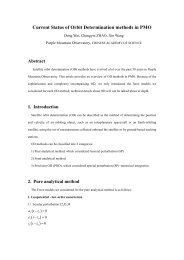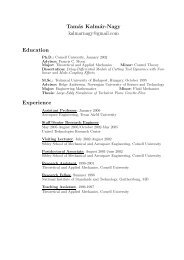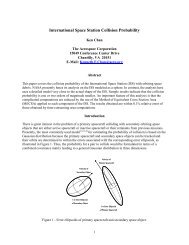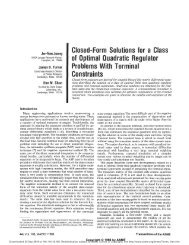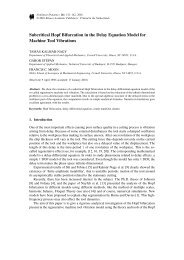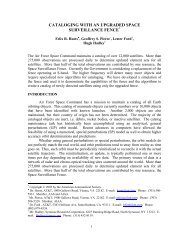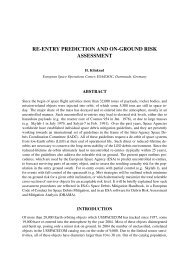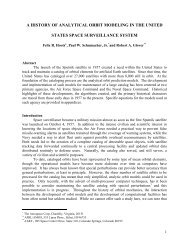Observer/Kalman-Filter Time-Varying System Identification - AIAA
Observer/Kalman-Filter Time-Varying System Identification - AIAA
Observer/Kalman-Filter Time-Varying System Identification - AIAA
You also want an ePaper? Increase the reach of your titles
YUMPU automatically turns print PDFs into web optimized ePapers that Google loves.
898 MAJJI, JUANG, AND JUNKINS<br />
because of the innovations property involved. The qualitative<br />
relationship between the identified observer realized from the<br />
TOKID calculations (GTV-ARX model) and the classical <strong>Kalman</strong><br />
filter is explained in the main body of the paper.<br />
Appendix B: <strong>Time</strong>-<strong>Varying</strong> Deadbeat <strong>Observer</strong>s<br />
I. <strong>Time</strong>-<strong>Varying</strong> Deadbeat <strong>Observer</strong>s<br />
It was shown in the paper that the generalization of the ARX model<br />
in the time-varying case gives rise to an observer that could be set to a<br />
deadbeat condition that has different properties and structure when<br />
compared with its linear time-invariant counterpart. The topic of<br />
extension of the deadbeat observer design to the time-varying<br />
systems has not been pursued aggressively in the literature, and only<br />
scattered results exist in this context. Minamide et. al. [13] developed<br />
a similar definition of the time-varying deadbeat condition and<br />
presented an algorithm to systematically assign the observer gain<br />
sequence to achieve the generalized condition thus derived. In<br />
contrast, through the definition of the time-varying ARX model, we<br />
arrive at this definition quite naturally, and we further develop plant<br />
models and corresponding deadbeat observer models directly from<br />
the I/O data.<br />
First, we recall the definition of a deadbeat observer in the case of<br />
the linear time-invariant system and present a simple example to<br />
illustrate the central ideas. Following the conventions of Juang [1]<br />
and Kailath [18], if a linear discrete-time dynamical system is<br />
characterized by evolution equations given by<br />
x k 1 Ax k Bu k (B1)<br />
with the measurement equations (assuming that C, A is an observable<br />
pair)<br />
y k Cx k Du k (B2)<br />
where the usual assumptions on the dimensionality of the state space<br />
are made, x k 2 R n , y k 2 R m , u k 2 R r , and C, A, and B are matrices<br />
of compatible dimensions. Then, the gain matrix G is said to produce<br />
a deadbeat observer if, and only if, the following condition is satisfied<br />
(the so-called deadbeat condition):<br />
A GC p 0 n n (B3)<br />
where p is the smallest integer, such that m p n and 0 n n is an<br />
n n matrix of zeros.<br />
II. Example of a <strong>Time</strong>-Invariant Deadbeat <strong>Observer</strong><br />
Let us consider the following simple linear time-invariant example<br />
to show the ideas:<br />
A<br />
1 0<br />
1 2<br />
C 0 1 (B4)<br />
Now, the necessary and sufficient conditions for a deadbeat observer<br />
design give rise to a gain matrix:<br />
such that<br />
G<br />
g 1<br />
g 2<br />
A GC 2 1 g 1 g 1 3 g 2<br />
3 g 2 g 1 2 g 2<br />
2<br />
giving rise to the gain matrix:<br />
(it is easy to see that p<br />
verified to be given by<br />
G<br />
1<br />
3<br />
0 0<br />
0 0<br />
(B5)<br />
2 for this problem). The closed loop can be<br />
A<br />
GC<br />
1 1<br />
1 1<br />
(B6)<br />
which is a defective (repeated roots at the origin) and nilpotent<br />
matrix. Therefore, the deadbeat observer is the fastest observer that<br />
could possibly be achieved, because in the time-invariant case, it<br />
designs the observer feedback, such that the closed-loop poles are<br />
placed at the origin. However, it is quite interesting to note that the<br />
necessary conditions, albeit redundant nonlinear functions, in fact<br />
have a solution that exists (one typically does not have to resort to<br />
least-squares solutions), because some of the conditions are dependent<br />
on each other (not necessarily linear dependence). This nonlinear<br />
structure of the necessary conditions to realize a deadbeat<br />
observer makes the problem interesting, and several techniques are<br />
available to compute solutions in the time-invariant case for both<br />
cases when plant models are available (Minamide et al. solution [13])<br />
and when only experimental data are available (OKID solution).<br />
Now, considering the time-varying system and following the<br />
notation developed in the main body of the paper, this time-varying<br />
deadbeat definition appears to have been naturally made. Recall<br />
[from Eq. (16)] that in constructing the GTV-ARX model of this<br />
paper, we have already used this definition. Thus, we can formally<br />
write the definition of a time-varying deadbeat observer as follows:<br />
Definition: A linear time-varying discrete-time observer is said to<br />
be deadbeat if there exists a gain sequence G k , such that<br />
A k p 1 G k p 1 C k p 1 ; A k p 2 G k p 2 C k p 2 ;<br />
... ; A k G k C k 0 n n (B7)<br />
for every k, where p is the smallest integer, such that the condition is<br />
satisfied.<br />
We now illustrate this definition using an example problem.<br />
III. Example of a <strong>Time</strong>-<strong>Varying</strong> Deadbeat <strong>Observer</strong><br />
To show the ideas, we demonstrate the observer realized on the<br />
same problem used in Sec. VI of the paper and followed by a short<br />
discussion on the nature and properties of the time-varying deadbeat<br />
condition in the case of the observer design. The parameters involved<br />
in the example problem are given (we repeat here for convenience) as<br />
2 3<br />
1 0<br />
1 1<br />
A k exp A c t ; B k<br />
6 7<br />
4 0 1 5 ;<br />
1 0<br />
1 0 1 0:2<br />
C k<br />
1 1 0 0:5 ; D k 0:1 1 0<br />
0 1<br />
where the matrix is given by<br />
with<br />
(B8)<br />
A c<br />
0 2 2 I 2 2<br />
K t 0 2 2<br />
(B9)<br />
K t<br />
4 3 k 1<br />
1 7 3 0 k<br />
and k and k 0 are defined as k sin 10t k and k 0 : cos 10t k .<br />
Clearly, because m 2 and n 4 for the example, the choice of<br />
p 2 is made to realize the time-varying deadbeat condition.<br />
Considering the time step k 36 for demonstration purposes, the<br />
closed-loop system matrix and its eigenvalues are [where M<br />
denotes the vector of eigenvalues of the matrix M] computed as





